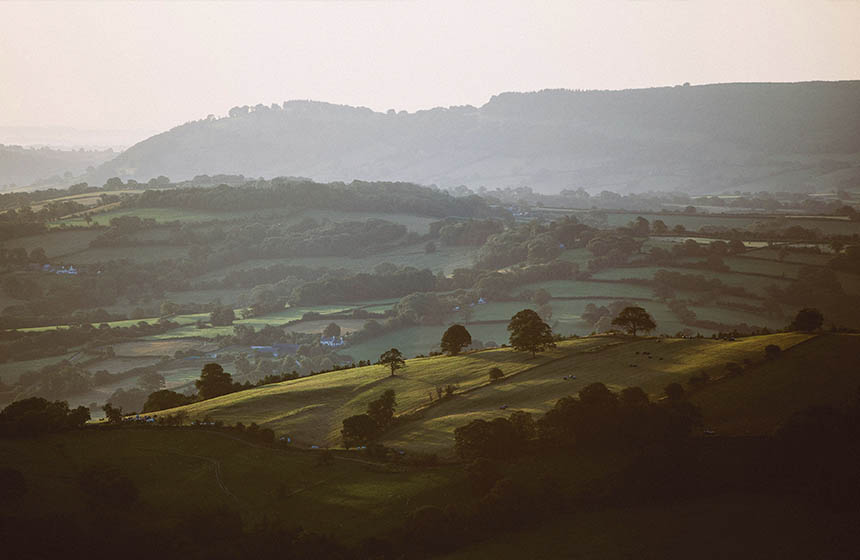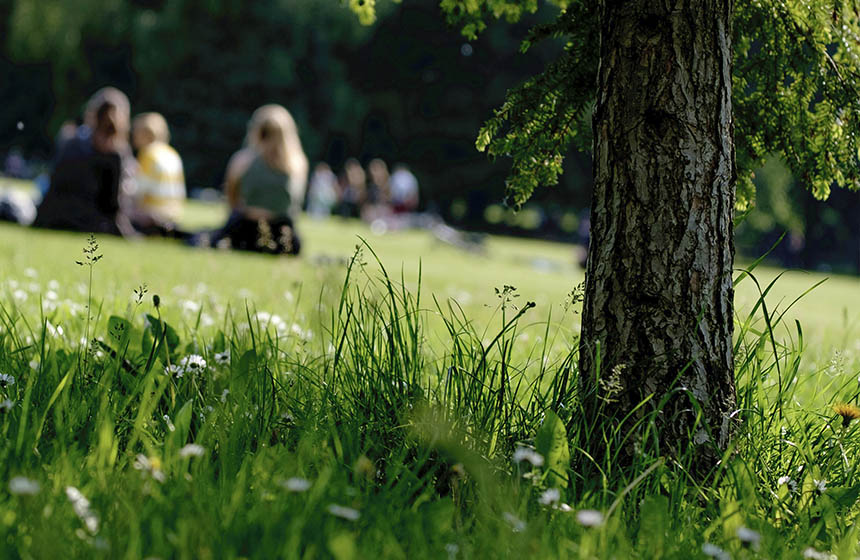The Carbon Community: Tackling knowledge gaps on carbon sequestration by trees and soil
The Carbon Community works in partnership with scientists and the community to analyse and establish effective reforestation strategies to increase carbon sequestration through tree planting, with soil microbiome inoculation and basalt addition.
Nature-based intervention:
In May 2021, The Carbon Community established a replicated field trial in Glandwr Forest to assess reforestation efforts that maximise carbon sequestration in trees and soil. Two novel approaches are being tested, soil microbiome inoculation and addition of crushed basalt, to evaluate whether this accelerates and enhances carbon sequestration in conifer monoculture and mixed broadleaf forests (1). Prior to planting, crushed basalt was applied to the fields using a modified lime spreader, and at the time of planting, soil samples from established conifer or broadleaf forests were added. Crushed basalt addition to the soil is thought to capture carbon dioxide, fertilise trees and potentially simulate mycorrhizal fungi growth.
Across 11 hectares of land with 25,600 planted trees, there are 8 treatments manipulating forest type, soil microbiome inoculation, and basalt addition, and one grassland control, replicated 8 times in a randomised design. This level of replication provides statistical robustness, allowing for possible differences in microclimate between the plots. The experiment tests whether the microbiome and basalt treatments improve tree seedling growth and survival rates. The main study was designed in partnership with scientists from 4 research institutions, with later contributions from 4 other research institutions.
Overview of context:
The Carbon Community aims to establish field research projects to increase carbon sequestration in reforestation. Their landmark project is the experimental trial launched at Glandwr Forest. This was established in May 2021 on upland grassland that was previously grazed, with patches of existing woodland, wetland and a small site of ancient woodland. The site is adjacent to a stream.
Case effectiveness on
Climate change
The project established at Glandwr Forest studies the effect of soil microbiome and enhanced weathering treatments on carbon sequestration and growth. In the first three years of the project, carbon stored in trees and soil have been measured, alongside tree measurements to track growth. Due to the early stage of the project, results have not yet been reported.
Given that tree growth takes time, impacts of inoculation of forest microbiome on supporting tree resilience to pests, disease, and drought conditions are yet to be established. However, The Carbon Community states that results are ‘positive’ so far (2). In addition, the comparison between mixed native broadleaf and monoculture Sitka spruce provides the opportunity to assess the climate adaptation benefits of different species for both restoration and commercial planting.
Ecosystem health
Ecological effect: PositivePrior to the planting of new woodland, red kites, hares, mink and red squirrel were present on the site. Project plans include objectives to increase biodiversity and increase connectivity of wildlife habitats. An invertebrate biodiversity study was established to determine the impact of woodland creation methods on below-ground and above-ground invertebrate communities, though results have not yet been reported (9). In addition, 120 black poplar trees, endangered in the UK, were planted on the site and have doubled in size 4 months later.
Socioeconomic outcomes
Community volunteering is an important goal of the project. Over 200 community volunteers have supported tree planting, tagging and research monitoring (4). In addition, university students are welcomed to conduct research projects on site.
Governance
Local participation in Governance: NoThe Carbon Community is a UK registered charity. It designs and hosts research projects and community science volunteer movement in partnership with ETH Zurich Crowther Lab, Leverhulme Centre for Climate Change Mitigation at the University of Sheffield, The Grantham Institute on Climate Change and the Environment from Imperial College London, The Royal Botanic Gardens, Kew, Nature-based Solutions Initiative at the University of Oxford, Swansea University and Bangor University. Projects are established on land owned by the charity.
Finance
The Carbon Community’s research is supported through donors such as The Pure Good Foundation and SAP, which has provided £75,000 towards research (3). In addition, a Glastir Woodland Creation grant will support tree planting and maintenance across two-thirds of the site.
Monitoring and evaluation
Monitoring is the main aim of the project; it aims to fill a knowledge gap around the carbon sequestration response to novel treatments to stimulate tree growth, as well as the difference between monoculture plantations of non-native Sitka Spruce and mixed native woodlands. Carbon stored in trees and soil has been monitored for the first three years (1), but this data has not yet been reported publicly. Volunteers are involved in cataloguing trees in the study. The Big Tree Measure was conducted in 2022 where volunteers measured 6,400 trees across 8 days (5). To assess the mycorrhizal communities across treatments, soil cores were taken around the base of tree stems, and the roots in the samples were assessed under microscopes (6). From 2022 to 2023, a total of 184 seedlings were sampled across the 72 treatments. To study basalt carbon sequestration, three different techniques are used, which involve soil sampling, use of lysimeters, and burying of litter bags with basalt (7).
The University of Oxford is studying biodiversity impacts alongside the carbon impacts, through monitoring invertebrate populations. This data is currently being analysed.
Trade-offs and limitations
The Carbon Community emphasises that site selection is of importance when establishing woodlands (8). Woodlands closer to people can provide additional benefits of recreation and improved health, but may be more expensive than land in remote areas given higher costs of land near centres of populations. As an organisation focussed on enabling research on maximising carbon sequestration, The Carbon Community has chosen a location which is accessible for researchers and community science volunteers.
References
- The Carbon Community. 2021. Announcing our Landmark Carbon Study. https://www.carboncommunity.org/carbon-projects
- The Carbon Community. N.d. Our trees in the drought. https://www.carboncommunity.org/carbon-community-updates/our-trees-in-the-drought
- The Carbon Community. N.d. FAQ. https://www.carboncommunity.org/faq
- The Carbon Community. N.d. Work alongside us, for the planet. https://www.carboncommunity.org/join
- The Carbon Community. 2022. The BIG Tree measure 2022 recap. https://www.youtube.com/watch?v=5A6WfRbXPVE
- The Carbon Community. N.d. Sampling the fungi that drive soil carbon sequestration. https://www.carboncommunity.org/carbon-community-updates/fungi-and-soil-carbon-sequestration
- The Carbon Community. N.d. How to measure rock weathering carbon sequestration: Explainer video. https://www.carboncommunity.org/carbon-community-updates/how-to-measure-rock-weathering-carbon-sequestration-explainer-video
- The Carbon Community. N.d. The different kinds of forest. https://www.carboncommunity.org/carbon-community-updates/different-kinds-of-forest
- The Carbon Community. N.d. Watch: University of Oxford start biodiversity survey at The Carbon Community.https://www.carboncommunity.org/carbon-community-updates/watch-university-of-oxford-start-biodiversity-study-at-the-carbon-community

Intervention type
- Created habitats
- Management
Ecosystem type
- Temperate forests
Climate change impacts addressed
- Drought
- Invasive species damage
- Increased pests
Instigators
- Local NGO or CBO (eg. indigenous)
- Research institutions
Societal challenges
- Climate change adaptation
- Disaster risk reduction
- Water security
Outcomes
- Food security: Not reported
- Water security: Not reported
- Health: Not reported
- Local economics: Not reported
- Livelihoods/goods/basic needs: Not reported
- Energy security: Not reported
- Disaster risk reduction: Not reported
- Rights/empowerment/equality: Not reported
- Recreation: Not reported
- Education: Positive
- Conflict and security: Not reported
- No. developmental outcomes reported: 2
Resources
Read resource 1Literature info
- Grey literature




